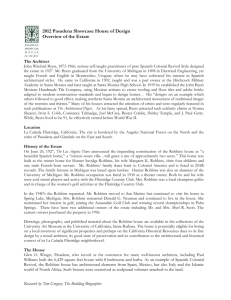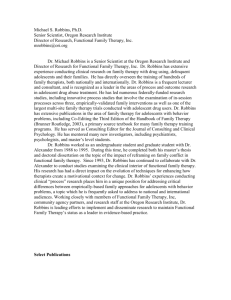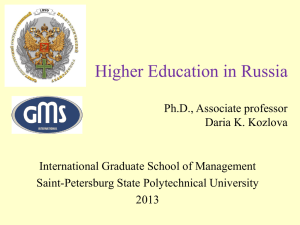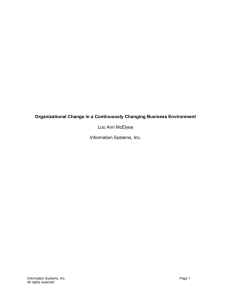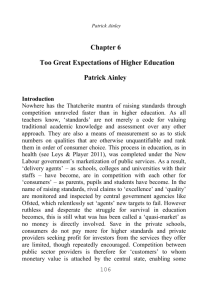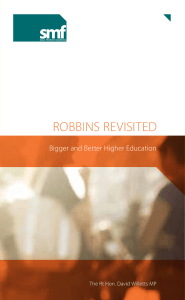More Means Better: 50 Years of Higher Education
advertisement
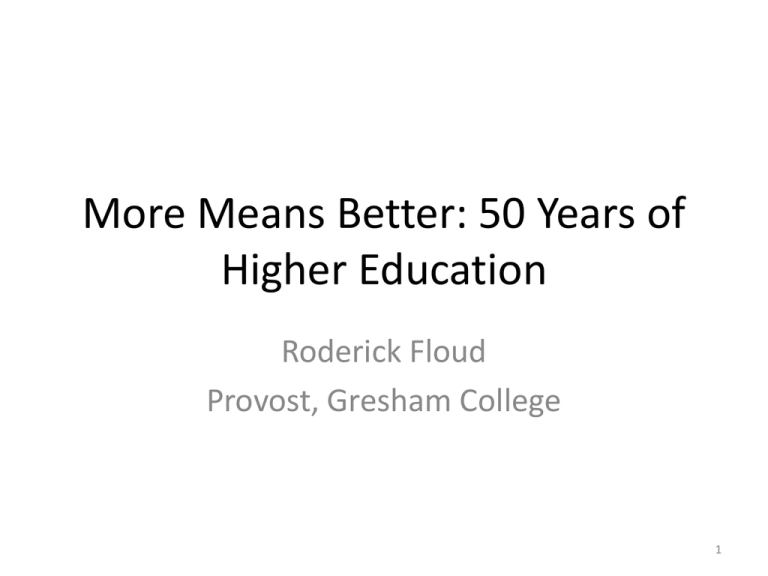
More Means Better: 50 Years of Higher Education Roderick Floud Provost, Gresham College 1 My career • Taught at University College London, Cambridge, Birkbeck College London and held Visiting Chair at Stanford. • Head of University for 18 years • Member, Economic and Social Research Council, 1993-1997 • Founder Convenor, London Higher Education Consortium, 19992001 • President of Universities UK, 2001-2003 • Vice-President of European University Association, 2005-2007 • Chair of Social Sciences Committee of European Science Foundation, 2007-2014 • Member of British Academy, AcSS and Academia Europaea and holder of seven honorary degrees and fellowships • Published 50 books and articles on economic history 2 1964-2014 and 2014-2064 • The Robbins Report and “More will mean worse” (Kingsley Amis). • What has happened since 1964. • British higher education in 2014 and what needs to happen now. 3 1964-2014 • More of everything: – More students in more universities – More women – More part-time students – More research – More European teaching and research – The world • More has meant better 4 Emerging from recession: Guardian 2/5/14 5 More students • “Throughout our Report we have assumed as an axiom that courses of higher education should be available for all those who are qualified by ability and attainment to pursue them and who wish to do so.” Robbins Report 1963 6 Students in tertiary education, Great Britain, 1900 - 2011 2500000 2000000 1500000 1000000 500000 0 1900 1924 1938 1954 1962 1999 2000 2001 2002 2003 2004 2005 2006 2007 2008 2009 2010 2011 2012 Source: 1900-1962 Robbins Report; 1999-2011 UNESCO 7 Participation in HE (% of age-group) Year Participation rate 1870 1 1902 1 1938 2 1954 3 1962 4 2004 28 2013 34 8 More women The % of graduates who are women Country Bachelor’s degree Doctoral degree Iceland 69% 44 Portugal 60% 62% OECD average 59% 46% UK 57% 45% USA 57% 53% China 47% 44% Japan 44% 28% Source: OECD, data for 2010 9 The “little woman” wins a Nobel prize in 1964 10 Male and female participation rates: England Source: HEFCE 2013, ‘Trends in young participation in higher education’ 11 More part-time students Source: Eurostudent 2006 12 Fall in participation of part-time students Part-time undergraduates in England, 2008 - 2013 300000 250000 200000 150000 100000 50000 0 2008-09 2009-10 2010-11 2011-12 2012-13 Part-time undergraduates Source: Derived from HEFCE 2013, ‘Trends in young participation in higher education’ 13 More research 14 Strength of the UK research base 15 More Europe • The European Higher Education and Research Areas: – The Bologna Process – EU framework programmes, Horizon 2020 and the European Research Council – The European Science Foundation/Science Europe 16 The world Enrolment in Tertiary Education 160000000 140000000 120000000 World 100000000 80000000 Developed countries 60000000 40000000 North America and Western Europe 20000000 Source: UNESCO 0 1999 2000 2001 2002 2003 2004 2005 2006 2007 2008 2009 2010 2011 17 The UK is extraordinarily attractive to international students Global % share of international student market Top 10 countries 18.00% 16.00% 14.00% 12.00% 10.00% 8.00% 6.00% 4.00% 2.00% 0.00% USA UK GER FRA AUS CAN (2010) RUS JPN CHN NZ Source: OECD 2013, ‘Education at a Glance’ 18 Dependence on overseas – ie not UK or EU -students • 20-30% overseas students (28) – Aston, Brunel, Cardiff Metropolitan, Courtauld Institute, HeriotWatt, Queen Mary, RAM, RCA, RCM, Royal Holloway, City, Bath, Cambridge, East Anglia, Edinburgh, Essex, Exeter, Lancaster, Leicester, Liverpool, Manchester, Nottingham, Oxford, Sheffield, Sunderland, Surrey, Sussex, Warwick, • 30-40% overseas students (6) – Glyndwr, Imperial, SOAS, Buckingham, UCL, Univ. of Arts • 40-50% overseas students (3) – LSE, School of Hygiene, St. Andrews • > 50% overseas students (1) – LBS 19 More has meant better • “This expansion has not been accompanied by any lowering of standards but rather the reverse.” Robbins Report 1963 20 2014 - 2064 • Expansion will continue • Mess, muddle or omnishambles • What needs to be done: – Too many universities, doing too many things – Specialisation and the reduction of duplication – Proper funding of research – Fund, not fund raise 21 Young entry rates to higher education 100 90 80 70 60 50 40 30 20 10 0 Source: OECD 2013, ‘Education at a Glance’ 22 Expansion will continue 18-yr old Participation rate England Scotland Wales 36% 35% 34% 33% 32% 31% 30% 29% 28% 27% 26% 25% 2004 2006 2008 2010 2012 Source: HEPI 2013, ‘The impact on demand of the Government’s reforms of higher education’ 23 Mess, muddle or omnishambles • “it is difficult to defend the continued absence of co-ordinating principles and of a general conception of objectives.” • … “the needs of the present and still more of the future demand that there should be a system.” Robbins Report 1963 24 Too many universities, doing too many things 25 Universities as hoteliers Major Banks - Branches of Santander & Barclays Restaurants – le Gusta oven & bar, the Dirty Duck, Xananas - to name a few Bars – the terrace bar, Arts Centre café bar Coffee shops – Curiositea, Costa Coffee Shops – the Bookshop, Costcutter, Student Union Market Post Office – located within Costcutter Hairdressers - Thompson & Murray Hair and Beauty Pharmacy 26 Universities as bus companies 27 Specialisation and the reduction of duplication 28 Research funding in the UK • The state through “dual support”: – The Higher Education Funding Councils – The Research Councils • Charities – e.g. Wellcome, Nuffield, Rowntree, Leverhulme, Cancer Research UK, etc. • Europe • Private industry 29 Proper funding of research? University Change in share of research funds, 19952014 (Percentage points) UCL + 3.2 Imperial + 2.8 Oxford + 1.7 KCL + 1.0 Bristol, Cambridge, Durham, Reading, Southampton, York + 0.1 to + 0.9 Birmingham, Lancaster, Leeds, Leicester, Liverpool, LSE, Manchester, Newcastle, Nottingham, Sheffield, Surrey, Sussex, Warwick - 0.1 to -0.9 Overall change + 6.0 30 Fund, not fund-raise 31 Higher education on the cheap Public investment in HE as percentage of GDP Private investment in HE as percentage of GDP Source: OECD 2013, ‘Education at a Glance’ 32 Conclusion • A great British success story – 2.8% of British GDP and export earnings of £10.7 billion p.a. • But also a mess and a muddle • We need to take a fresh look – a new Robbins report • Meanwhile: – – – – Fewer universities Specialise Reform research funding Forget fund-raising and • Fund British higher education properly 33
![The Next 50 Years: Imagining the University of the Future [PPT 2.25MB]](http://s2.studylib.net/store/data/015030210_1-a54d391ee5cd497a682b0e9466b5743e-300x300.png)





